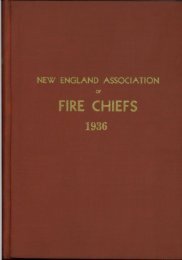NEAFC 31st Annual Conference.pdf - New England Association of ...
NEAFC 31st Annual Conference.pdf - New England Association of ...
NEAFC 31st Annual Conference.pdf - New England Association of ...
You also want an ePaper? Increase the reach of your titles
YUMPU automatically turns print PDFs into web optimized ePapers that Google loves.
NEW ENGLAND ASSOCIATION OF FIRE CI-IIEI~S<br />
~dental asphyxiation, while in the year following the introduction <strong>of</strong> natural gas, these<br />
same 20 companies reported no deaths from gas inhalation,. There ale three obvious,<br />
major reasons why.<br />
First, <strong>of</strong> course, is the fact that natural gas co.ntains no carbon monoxide and is,<br />
therefore, nor~-toxic. Second, the limits <strong>of</strong> inflammability <strong>of</strong> naturaI gas are much narrower<br />
than those <strong>of</strong> manufactured gas. Third, the uniformity <strong>of</strong> the product provides<br />
greater ease <strong>of</strong> control and better operation .<strong>of</strong> applilnces. As you doubtless, kn.ow,<br />
natural gas--as furnished; by Northeastern Gas Trari~mission Company--comes from<br />
the Gulf Coast area <strong>of</strong> the United States, and is approximately 94 per cent methane<br />
with small amounts .<strong>of</strong> ethane and heavier hydrocarbons. All <strong>of</strong> the gas from the<br />
Gulf Coast area is surprisinigly unif~orm in chemical’ composition, specific gravity, anc~<br />
thermal heating content. The manufactured gases Wl~ich this natural ga,s replaced all<br />
contained varying amounts .<strong>of</strong> carbon monoxide in q~i~tntities up to 30 per cent. This,<br />
<strong>of</strong>~ course, provided a ready avenue for suicides and Yeas responsible for a considera’ble<br />
number <strong>of</strong> accidental asphyxiations each year..<br />
Again, in spite <strong>of</strong> the dire prophecies <strong>of</strong> natural ~a~ performance, there have been<br />
no pipelihe explbsions in <strong>New</strong> <strong>England</strong>’---and we do not expect any. I do not wish<br />
to deny the fact that there have .been explosions .<strong>of</strong> natural gas pipelines in the past,<br />
nor that i.t is impossible for similar explosion.s to occur in the future, but I do wish to<br />
emphasize the fact that hazards connected with such explosions, have been greatly exaggerated<br />
b) people who oppose natural gas for persQnal reasons. As a matter <strong>of</strong> fact,<br />
there were approximately l lY,000 miles <strong>of</strong> high-pressure, large-diameter natural gas<br />
pipelines in the Unit4d States in 19~1, and approximately 342,000 miles <strong>of</strong> natural gas<br />
distribution mains suppl-ying approximately 3 trillion cubic feet <strong>of</strong> natural gas to sixteen<br />
million gas customers, representing 21 per cent <strong>of</strong> the nation,’s fuel supply. Approxim~ttely<br />
~00 miles <strong>of</strong> these high-pressure gas mains are located in <strong>New</strong> <strong>England</strong>. Unfortunately,<br />
I do n.ot have statistics for all pipeline companies for recent years, but I<br />
do have the information relative to my own company.<br />
Tennessee .Gas, Transmission .Company and Northeastern have over 6,000 miles<br />
<strong>of</strong> large-diameter pipelines, which have been in operation for periods from one to nine<br />
years, at pressures from Y00 to 100.0 pounds. The total mile-years <strong>of</strong> operation repre.<br />
sented~ by this system is approximately 20,000. This means the equivalent <strong>of</strong> 20,000<br />
miles <strong>of</strong> pipeline operatin.g for one year or, conversely, one mile <strong>of</strong> pipeline operating<br />
for 20,000 years. During this! period, Tennessee has had 10 expl.osions on operating<br />
pipelines, or an average <strong>of</strong> one explosion for each 2,000 mile-years. Again, this<br />
simply means that the probability <strong>of</strong> an explosion on any single mile <strong>of</strong> Tennessee Gas<br />
pipeline system is one in., each 2000 years, and in all its operation there has never been<br />
a case .<strong>of</strong> death or serious injury to anyone other than pipeline company personnel or<br />
workmen on pipeline projecets. I quote these figures simply to call your attention to<br />
the extremely minor extent <strong>of</strong> the hazard, so that you may properly evaluate the state~<br />
ments which are made from time to time regarding the hazards attendant on natural<br />
gas transmission. And to further lessen the hazard, you must realize that steel tubular<br />
products and methods..<strong>of</strong> pipeline installation are being continually improved so that<br />
the pipelines in <strong>New</strong> <strong>England</strong> should have an even lesser probability <strong>of</strong> failure than those<br />
on the average <strong>of</strong> rrennessee’s ,system--some .<strong>of</strong> which are ten years old, at this time.<br />
Na.tural gas is not a new product, but is only new to <strong>New</strong> <strong>England</strong>. It has been<br />
frequently pointed out that natural gas was first discovered an,d used many centuries<br />
ago. In fact, our first written reference to this gas is probably in the Old Testament;<br />
195.









